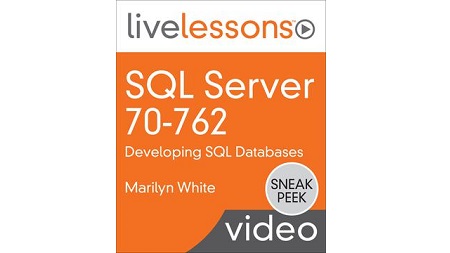
English | MP4 | AVC 1280×720 | AAC 44KHz 2ch | 5h 49m | 3.14 GB
In the SQL Server 70-762: Developing SQL Databases video training course, renowned SQL Server trainer Marilyn White guides you through every concept and skill you’ll need to effectively design and implement database objects.
Ideal for all working and aspiring SQL Server database professionals, this course combines incomparable hands-on 70-762 exam preparation with practical skill-building for real-world data management.
Inside:
- Design and Implement a Relational Database Schema
- Design and Implement Indexes
- Design and Implement Views
- Implement Columnstore Indexes
- Implement Programmability Objects
- Ensure Data Integrity with Constraints
- Create Stored Procedures
- Create Triggers and User-Defined Functions
- Manage Database Concurrency
- Implement Transactions
- Manage Isolation Levels
- Optimize Concurrency and Locking Behavior
- Implement Memory-Optimized Tables and Native Stored Procedures
- Optimize Database Objects and SQL Infrastructure
- Optimize Statistics and Indexes
- Analyze and Troubleshoot Query Plans
- Manage Performance for Database Instances
- Monitor and Trace SQL Server Baseline Performance Metrics
Table of Contents
01 SQL Server 70-762 – Introduction
02 Module Introduction
03 Learning objectives
04 1.1 Designing Tables and Schemas Based on Business Requirements
05 1.2 Lab – Building the Design
06 1.3 Improving the Design of Tables by Using Normalization
07 1.4 Lab – Implementing Normalization
08 1.5 Writing Table Create Statements
09 1.6 Lab – Creating Tables
10 1.7 Determining the Most Efficient Data Types to Use – Categories, Precedence, Conversion, Considerations, and Keys
11 1.8 Determining the Most Efficient Data Types to Use – Identity and Sequence
12 1.9 Determining the Most Efficient Data Types to Use – Computed Columns, Numeric, and Date_Time
13 1.10 Determining the Most Efficient Data Types to Use – Character, Unicode, Binary String, and Other Data Types
14 1.11 Lab – Reviewing Data Types and Their Applications
15 1.12 Extending Security to Data Types by Using Dynamic Data Masking
16 1.13 Lab – Using DDM Functions
17 Lesson 1 Summary
18 2.1 Designing New Indexes Based on Provided Tables, Queries, or Plans
19 2.2 Lab – Implementing Indexes
20 2.3 Distinguishing Between Indexed Columns and Included Columns
21 2.4 Lab – Distinguishing Between Indexed Columns and Included Columns
22 2.5 Implementing Clustered Index Columns by Using Best Practices
23 2.6 Lab – Choosing the Clustered Index Columns Based on Best Practices
24 2.7 Recommending New Indexes Based on Query Plans
25 2.8 Lab – Analyzing Query Plans for Indexing Improvements
26 Lesson 2 Summary
27 3.1 Designing a View Structure to Select Data Based on User or Business Requirements
28 3.2 Lab – Implementing a View Structure
29 3.3 Identifying the Steps Necessary to Design an Updatable View
30 3.4 Lab – Analyzing the Effects of DML Statements Using a VIEW Object
31 3.5 Implementing Partitioned Views
32 3.6 Lab – Configuring and Using Partitioned Views
33 3.7 Implementing Indexed Views
34 3.8 Lab – Configuring and Using Indexed Views
35 Lesson 3 Summary
36 4.1 Determining Use Cases That Support the Use of Columnstore Indexes
37 4.2 Lab – Understanding the Conceptual Format of Columnstore Indexes
38 4.3 Identifying Proper Usage of Clustered and Non-clustered Columnstore Indexes
39 4.4 Lab – Using Clustered Columnstore Indexes in Dimensional Data Warehouse Structures
40 4.5 Lab – Using Non-clustered Columnstore Indexes in OLTP Tables to Support Analytics
41 4.6 Designing Standard Non-clustered Indexes in Conjunction with Clustered Columnstore Indexes
42 4.7 Lab – Adding Non-clustered Indexes to Clustered Columnstore Indexes
43 4.8 Implementing Columnstore Index Maintenance
44 4.9 Lab – Using the ALTER INDEX Statement
45 Lesson 4 Summary
Resolve the captcha to access the links!